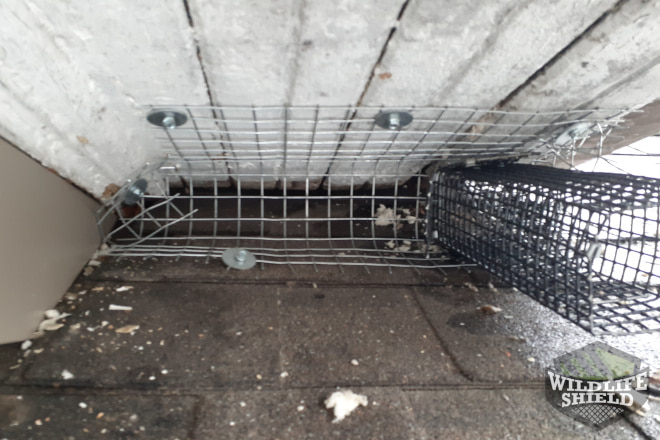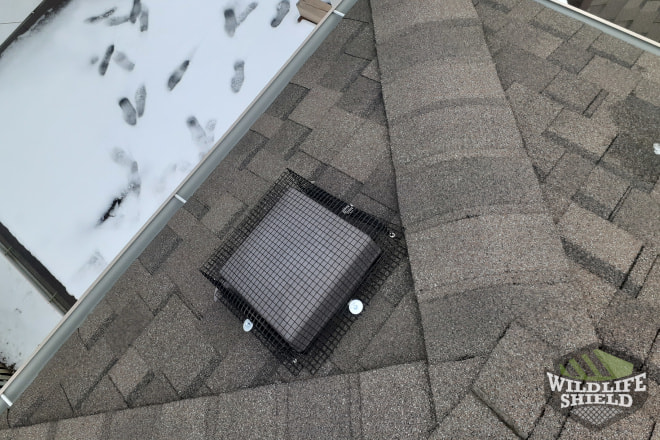The following case study details a squirrel removal job in Old Toronto. A squirrel that was found nesting in the second storey soffit of a single-family home was removed humanely with the installation of a one-way door. No squirrels were harmed in the process. If there are squirrels in your area and you need help, reach out to Squirrel Control. Our technicians are trained and experienced in the humane removal of squirrels.
Inspection
The homeowner of this single-family home called us when they suspected that squirrels had entered their home. They had often seen a squirrel climb onto the roof, and they could hear chewing and rustling sounds coming from the ceiling. It was February, so getting onto the roof themselves was not very safe. One of our technicians came to inspect the property the next day.
With every job, our technicians perform detailed inspections. This not only determines where the squirrel is entering the home but every other vulnerability that could invite more squirrels in the future. Knowing where squirrels may break in again allows us to wildlife-proof the property, sealing and excluding every possible entry point.
Here, the technician found the squirrel’s entry point where a soffit met the roof below. There was a clear hole in the roof, with chew marks and bits of wood surrounding it, indicating that a squirrel had bitten its way through. Animals often break into attics here because it is easily accessible. They can stand on the roof and push or chew their way through the soffits.

The squirrel in this case was likely female. Squirrels breed in late winter, then have their babies sometime between March and April. Later, they have another litter between July and August. It is during these mating seasons that females find a place to nest, which can be a hollowed tree, a canopy, or within an attic. Attics are nice and warm and above ground.
Given that it was early April, the technician was certain that there were no babies in the nest. The problem had been caught early enough that the mother squirrel could be removed right away. Female squirrels usually have a few nests, so as long as there are no babies inside, she will simply move to another one of her nests nearby.
To remove her, the technician proposed having a one-way door installed to the entrance of her nest, then excluding other vulnerabilities. There were roof vents and other intersections that she could break through after her removal, so it would be wise to have them excluded. The homeowner agreed to the treatment and the technician got started right away.

Removal and Exclusion
First, the technician installed a one-way door to the squirrel’s entry point. Like an open-ended trap, the door would let the squirrel crawl through, then close behind her. This is a totally humane solution. The squirrel would leave on her own terms, then be unable to come back inside.

Following the one-way door, the technician screwed mesh into the other roof-soffit intersection just a few feet away from the one the squirrel chewed through. This would prevent her from chewing and clawing her way through after her eviction on the other side.

Next, the roof vents were covered in mesh. The mesh used was a 16-gauge, galvanized, quarter inch steel that cannot be chewed by rodents. Raccoons can’t get through it either. Because it is galvanized, the mesh would withstand the weather and not rust for many years to come.
When everything was done, the technician let the homeowner know that the removal process may take a few days. Squirrels often come and go from their nests every day, but they can be spooked by the technician and hide for some time. To be safe, the technician would return in a week or two. He would then remove the door and replace it with mesh.

Conclusion
Within only a week, the squirrel was gone. She had likely moved into another one of her nests nearby. The technician returned a few days later and replaced the door with more mesh. This way, the squirrel would be unable to return.

Squirrels have strong teeth that let them manipulate their environments. When they find an opening on the edge of the roof, they may chew their way inside. Attics are popular nesting spots, so it’s important that you have your roof excluded. Call Squirrel Control for guaranteed exclusion in the Greater Toronto Area.